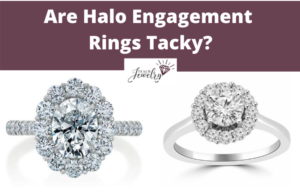
Halo settings are one of the most popular styles for engagement rings.
With a ring of small diamonds centered around the main one, it often gives the illusion of a larger gem without the added cost of a higher carat weight.
Halo engagement rings generally aren’t tacky. But before you select one, it’s important to understand their primary traits, when they might be considered tacky, and how to choose the right one for you.
What is a Halo Engagement Ring?
Halo engagement rings are named after the small circle of diamonds that surrounds the main one.
In the example below, I’ve highlighted the halo.
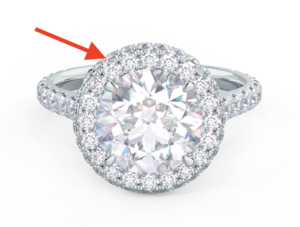
Notice how the accents are placed tightly together around the diamond, with barely any gap between them. They’re pressed around it to mimic the shape of the center diamond.
A halo setting can include more than the ring of diamonds.
For instance, you’ll often find the ring lined with pavé. It causes the ring to sparkle from every angle when it’s twirled, because light reflects off the diamonds on the band, the center gem, and the halo.
The halo diamonds don’t have to match the cut of the one they surround. Though the most popular design has round cuts in both positions, this 14K white gold setting features a princess cut in the middle.
Its halo provides a clear contrast.
This demonstrates the versatility of halo settings when used in engagement rings.
Pros
The primary advantage of halo settings is they improve brilliance without as high a cost of increasing the carat weight of the center diamond.
The price of a diamond doesn’t increase linearly. It’s exponential.
To demonstrate, I examined prices for more than 500 diamonds that earned the same grades across color, cut, and clarity, but they had different carat weights.
Here’s a chart with the average prices.
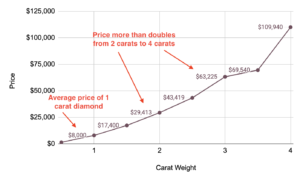
You can see the average price of the one-carat diamonds in my study was $8,000. But if you double it to two carats, the price jumps to $29,413 — an increase of 267 percent.
But adding several small diamonds as a halo doesn’t result in this same price increase.
Here’s a comparison.
This 14K white gold solitaire setting costs $250.
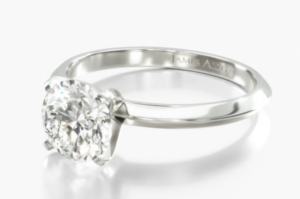
This 14K white gold halo setting costs $1,100.
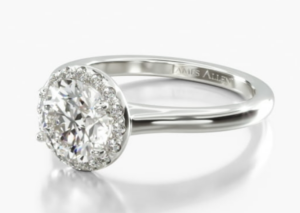
The halo features 20 round-cut diamonds with a total carat weight 0.12.
If you were to add 0.12 carats to the center diamond, it would cost more than $850 difference between the halo and solitaire.
So you’ll have enhanced brilliance for a lower cost with a halo engagement ring setting.
The other benefit is the variety of halo designs.
For example, you don’t have to stick with a single ring of diamonds. Instead, consider a double halo.
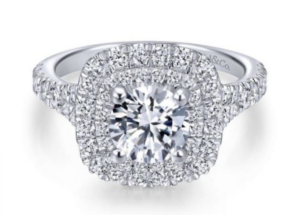
You’ll have even more brilliance, and it can give the impressions of a larger center diamond.
If you want an alternative to the traditional style, opt for a floral halo.
They’ll often include round cuts, but the way they’re positioned around the center diamond creates a unique shape.
Check out this example, where micro-prong diamonds form the floral halo.
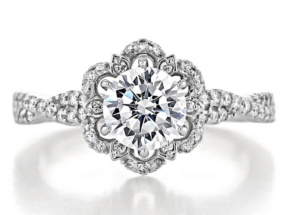
Take time to explore the different designs available with this type of setting.
Cons
There are also downsides to halo settings, and some result in a tacky aesthetic.
The first is that the style dilutes the focus on the main diamond.
The center diamond is often the most prominent aspect of the ring. It’s the most expensive, and buyers generally want to draw as much attention to it as possible.
Adding a halo has the potential to diminish its appearance on the piece because they blend together. This is especially true if you’ve chosen a small diamond and large halo.
To illustrate, here’s an engagement ring with a large halo surrounding a small diamond.
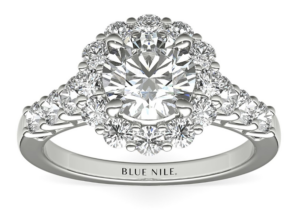
There’s also accents halfway down the band.
At first glance, you hardly notice the round-cut in the middle.
This isn’t always an undesirable feature, but it’s worth considering.
Although there’s cost savings with that choice, many prefer the opposite and want the main diamond to earn most of the attention.
Another disadvantage of halo settings is the difficulty of repair. This is true of any setting with a significant number of small diamonds, whether they surround the main one or line the band.
If one falls and is lost, you’ll need to replace it with one that’s the same size and matches the other in color and clarity. You want to keep its cohesive appearance.
As a contrast, solitaire settings only include a center diamond, so any repairs involving prongs or resetting the gem are much easier.
If your halo engagement ring needs repair, I recommend consulting with a local jeweler.
How to Avoid a Tacky Halo Setting
Certain halo settings might appear tacky, but there are a few guidelines you can use to avoid it.
The first is err toward a smaller halo versus a large one.
Not every large halo setting — such as one with two or three layers — is tacky, but it does increase the chances.
For example, here’s a triple halo with a total carat weight of three.
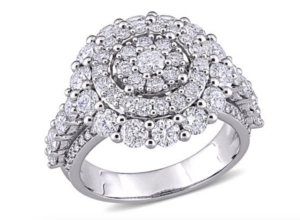
There are so many diamonds on this piece, and the halo extends far outside the center. There’s no focal point on the ring that draws your eye.
It’s hard to decide the main appeal, and the excessive diamonds could be viewed as tacky.
If you removed the third layer and the diamonds lining the shank, you’d have a more simple and elegant piece.
You also want to avoid a design where the halo clashes with the center diamond. The key word is “complement.” The halo should complement the main diamond and not distract from or overpower it.
If what is supposed to be the center gem turns into a sideshow, you might end up with a tacky setting.
There’s no hard and fast rules here, but those are factors to consider when you’re exploring settings.
Conclusion
Halo settings are a common choice for engagement rings. They offer an alternative to the classic solitaire in a way that enhances light performance without a significant increase in price.
In fact, I pulled data on Google searches for “halo setting” to learn how buyer behavior has changed in recent years. As you can see in the chart below, interest peaked in late 2021, and it’s generally held steady the last couple years.
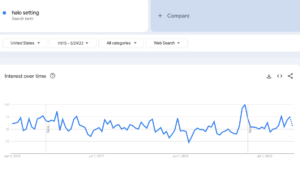
If you’re concerned about your halo engagement ring being tacky, my recommendation is to keep the design simple without detracting from the main diamond.
By doing so, you’ll create a stunning engagement ring that will last a lifetime.
Halo Engagement Rings Q&A
Q: How can different metal colors enhance or diminish the aesthetic appeal of halo engagement rings?
A: The choice of metal color can significantly impact the overall look of a halo engagement ring. For instance, a white gold or platinum setting might complement the brilliance of the diamonds, while a yellow or rose gold setting can add a vintage or romantic touch, potentially enhancing the visual appeal of the halo.
Q: What are some alternative gemstones for halo settings if one prefers a colored gemstone instead of a diamond?
A: Gemstones like sapphires, rubies, and emeralds are popular choices for halo settings. Their color can provide a stunning contrast to the surrounding diamonds, creating a unique and eye-catching look.
Q: Are there setting styles that can combine the halo with other popular ring styles?
A: Absolutely, halo settings can be combined with other styles like the three-stone, solitaire, or vintage styles, offering a blend of traditional and modern aesthetics.
Q: How can one ensure the diamonds in the halo match well with the center diamond or gemstone?
A: It’s crucial to ensure the diamonds in the halo are well-matched in color, clarity, and cut to the center diamond to maintain a cohesive and harmonious appearance.

Jacob Clarke
Jacob Clarke is the founder of TeachJewelry.com.
He earned an Applied Jewelry Professional Diploma from the Gemological Institute of America (GIA) and now brings you essential information about diamonds, settings, and more.
Jacob has consulted with leading jewelry brands, and his work has been cited in Clean Origin, Diamond Nexus and industry publications.
He's also a member of the International Gem Society.
He enjoys discussing jewelry with readers, so contact him with any questions at jacob.clarke@teachjewelry.com.













